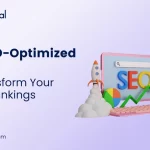
Which Activities Will Not Help in Lead Generation Service
December 9, 2024
How SEO-Optimized Content Can Transform Your Search Rankings
December 12, 2024A well-organized and creative website is important for companies looking to expand their online presence. Its usage goes beyond design and mostly depends on structure and well-written information. A well-designed website engages users, meets their requirements, and conveys messages in an easy-to-understand way.
In order to create a perfect website, careful planning and knowledge of your target audience are necessary. Here’s a guide to developing a well-organized website.
What to Consider When Developing Your Website Content
- Understand Your Audience
Recognize your website’s target audience. Take into account their requirements, preferences, and behaviour. Make sure your content is tailored to their needs or solves their problems. - Set clear objectives
Identify if your website’s goal is to engage, sell, inform, or amuse. The content approach for your website will be guided by certain goals. - Focus on Search Engine Optimization
To increase your search engine rating, make use of meta descriptions, headers, and relevant keywords. SEO makes sure the correct people see your website. - Keep It Simple and Engaging
Stay away from jargon. Write easily readable and intelligible information that is clear, succinct, and captivating. Utilize multimedia and images to break up the monotony. - Display Your Unique Value Proposition
Explain in detail why your information, service, or product is superior to that of your competitor. Emphasize the distinctive features of your brand. - Ensure Mobile Responsiveness
Check if your website is mobile-friendly because most people visit websites through smartphones. - Plan for Regular Updates
Visitors may be turned off by outdated content. Plan updates to maintain the freshness and relevance of your website.
How to Develop Your Website:
Organize Your Website Structure
- Make a layout or sitemap that lists the primary pages and sections, such as Home, About Us, Services, Blog, and Contact.
- Choose the navigation and user journey.
Select Domain and Hosting
- Pick a domain name that accurately represents your business and is simple to recall.
- Select a reputable hosting company based on uptime and performance.
Design and Layout
- Choose or create a theme that complements your brand.
- Make sure the design is clear, easy to use, and navigable.
Create and Organize Content
- Consider your audience and search engine optimization while creating content for each page.
- Try to use bullet points, headlines, subheadings, proper spaces, and pictures for better readability.
Develop Functionality
Add necessary elements, like call-to-action buttons, a search bar, and a contact form.
- Test all links and features and optimize for quick loading times.
Optimize for SEO
- Use relevant keywords, optimize images, and include alt text.
- Ensure all pages have meta tags and descriptions.
Test Your Website
- Verify compatibility by testing on various hardware and browser combinations.
- Verify loading times, problems, and broken links.
Launch and Monitor
- Launch the website and monitor its performance through tools like Google Analytics.
- Gather user feedback and make adjustments as needed.
In summary, careful attention to detail and strategic thought are necessary while creating a website. A smooth user experience and audience-centric content can help your website accomplish its goals and differentiate itself in the competitive digital market.
What should I consider when developing a website?
When developing a website, consider your target audience, clear objectives, SEO, mobile responsiveness, and regular updates. Focus on simple, engaging content and highlight your unique value proposition.
How do I identify my website’s target audience?
Understand your audience by considering their needs, preferences, and behaviors. Tailor your content to solve their problems or meet their expectations.
Why is SEO important for my website?
SEO helps increase your website’s visibility on search engines, attracting the right audience and improving your search engine ranking with relevant keywords and meta descriptions.
How do I make sure my website is mobile-friendly?
Test your website on various mobile devices to ensure it is responsive, easy to navigate, and properly formatted for smartphones and tablets.
What should I do after launching my website?
After launching, monitor its performance using tools like Google Analytics, gather user feedback, and make adjustments to improve user experience and website functionality.



